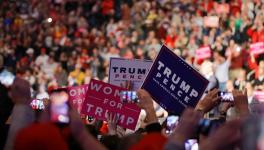Long and Winding Road for US-China Trade Talks
US-China talks at Osaka led by President Donald Trump and President Xi Jinping, Osaka, June 29, 2019
The spotlight at the G20 summit in Osaka was undoubtedly on the meeting last Saturday between President Donald Trump and his Chinese counterpart Xi Jinping. Much of the ‘feel-good’ impression of that event was based on three things.
One, Trump’s upbeat remark that it was a ‘very, very good meeting, better than expected. We’re right back on track’ exuded optimism. Two, the disclosure that US had agreed not to impose any further tariffs on Chinese goods and the announcement of an agreement to resume economic and trade negotiations conveyed a sense of breakthrough. Three, Washington’s concession to US technology companies’ concerns on supply-chain sourcing to Huawei wore the look of an overall conciliatory approach.
However, it is sinking in that the two presidents agreed only to resume their trade negotiations. And the US and China are no nearer to reaching consensus on a trade deal than they were when the talks faltered in early May. Several major trade issues still need to be addressed. The Chinese side has been lowering any high expectations of a swift resolution of the trade war.
This cautious approach on the part of Beijing stems from the fact that narrowing the outsize merchandise trade imbalance is only one aspect of the ‘trade war’ — and, arguably, not even the core issue — while far more formidable challenge lies in tackling the structural aspects of systemic conflict between the two big powers.
The trade imbalance part is relatively easy to tackle if China adopts an ‘open wallet’ approach to buy more from the US and resort to the ‘soybean strategy’ (commitment to purchase US agricultural products.) But then, how far this helps the US to tackle its multilateral trade problem is a different matter. (The US ran trade deficit with 102 countries in 2018.) Fundamentally, the problem lies in the US economy’s widening federal deficit over the next decade. In sum, tariff war with China can only backfire by shifting US imports to higher-cost foreign producers.
On the other hand, the structural issues — causing tensions in agriculture, services, technology, intellectual property, technology transfer, non-tariff barriers — are much for formidable and no solution is in sight. To be fair, Trump acknowledged it saying the US ‘does not feel rushed to do a deal’. In order to get a sense of the multiplicity and complexity of structural issues that divide these two very different systems — the US and China — it is useful to dip into the pre-Osaka Chinese white paper released in Beijing on June 2 titled China’s Position of the China-US Economic and Trade Consultations.
The salience of the document lies in Beijing’s determination not to give in on its commitment to indigenous innovation, the important role played by State-owned enterprises, and the country’s strategic focus on emerging industries such as artificial intelligence, fintech, e-commerce, and health science technologies.
The above are non-negotiable principles for China, whereas, the US regards them to be existential threat to American prosperity and the US’ dominance of the world economy. Trump’s China advisor Peter Navarro starkly posed the existential challenge: “China has targeted America’s industries of the future… If China successfully captures these emerging industries, America will have no economic future.”
This aspect of the US-China conflict is strategic and hugely political and cannot be resolved unless there is a profound shift in the American mindset. Osaka simply sidestepped the calculus. This explains why China is not exactly over thrilled by Trump’s ‘concessions’ that Silicon Valley companies will be allowed to sell chips to Huawei or that Chinese students will be on fast track to get green cards in America.
From the Chinese perspective, Trump’s propensity to weaponise trade policy by sanctioning the technology companies such as ZTE or Huawei and his ever-present use of tariffs or sanctions hangs like the Sword of Damocles in the epochal Sino-American conflict. In his speech at the G20 summit, Xi Jinping highlighted a new set of initiatives in this area — China’s new Foreign Investment Law, an updated negative list that narrows trade barriers in agriculture, mining, manufacturing, and services, six new free trade zones, and tariff reductions aimed at further encouraging imports. But is that sufficient to calm the agitated American mind?
Suffice to say, the truce at Osaka has a context — Trump’s compulsions in US domestic politics. The point is, the trade war with China has begun to hurt the US economy in a very significant way. The expert opinion is that while the US tariff hikes on $200 billion of Chinese goods may chip away 0.1 percent of China’s GDP in the coming year, the impact of a retaliatory Chinese tariff increase from 10-25 percent on $200 billion of its imports from the US could directly penalise some 0.3 percent from growth in the American economy in the coming year.
Again, the politically sensitive US farm sector takes a big hit. Trump has so far given a $12 billion bailout package. But even if he were to come up with another bailout of $15-$20 billion, it might be too little too late. Meanwhile, other industries could demand similar packages too. Indeed, even advanced industries are affected, including semiconductor giants and technology conglomerates (eg., Apple and TTM Technologies) or consumer and auto companies (eg., Nike and Cooper-Standard), which earn substantial percentage of their revenues from China.
Evidently, the White House urgings on US companies to move their supply chains away from China have only few takers because such proposed moves will come only at a high cost, given the fact that the high-level technology and logistics infrastructure comparable to China’s is hard to replace — and, inevitably, cost of production will go up damaging the companies’ global competitiveness. Make no mistake, China is the world’s largest and most rapidly-growing market and which US company would want to reduce its presence in that country and sacrifice a vital future source of income? Apple just announced that Mac Pro, which retails for US$5,999, will be manufactured in China.
Meanwhile, the collateral damage of the trade war is spreading in the US economy. The economic growth is likely to remain below 2.5% this year and decelerate to 1.8% in the crucial 2020 election year. The vulnerability to a recession risk is also there. If the trade talks fail and Trump chooses to impose punitive tariffs on all Chinese goods, it would be harder for US companies to pass on the costs to consumers, which in turn would compromise these companies’ competitiveness.
A commentary by Xinhua noted: “The easing of trade tensions between China and the United States came as no big surprise, as it is common wisdom that a trade war will not address the sticking points between the two sides, only dialogue can… China and the United States, after decades of engagement on all fronts, are so interconnected that it is just impractical and impossible to disentangle them. Nobody knows this better than U.S. companies which rely on the Chinese market for production and sales. Any attempt to sever the two countries’ economic and trade ties will prove painful and fruitless… That’s why the voice against additional tariffs has been so loud in the United States, particularly among the business community.”
Simply put, there is no alternative to a reassessment of the US’ unilateral geopolitical objectives on China, which grate against economic realities. Trump knows by now that coercion will not work with China — and, equally, that the truce at Osaka does not mean that a deal with China is imminent.
Get the latest reports & analysis with people's perspective on Protests, movements & deep analytical videos, discussions of the current affairs in your Telegram app. Subscribe to NewsClick's Telegram channel & get Real-Time updates on stories, as they get published on our website.
























